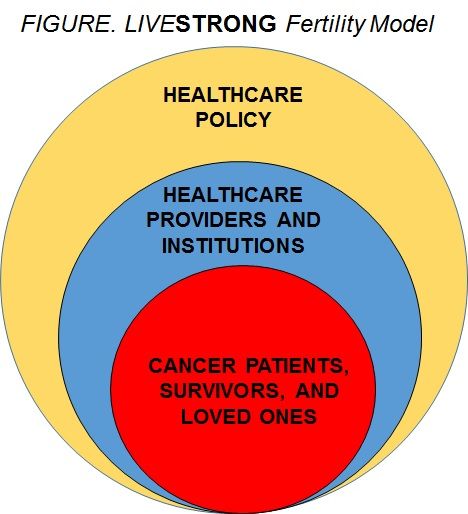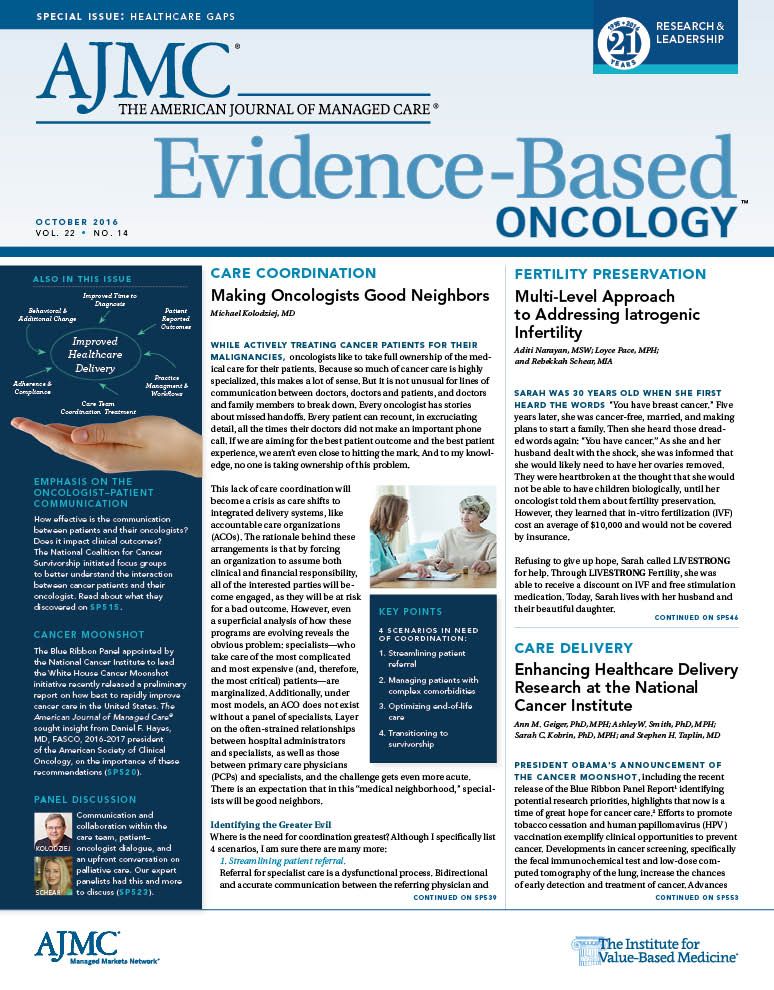Publication
Article
Evidence-Based Oncology
Multi-Level Approach to Addressing Iatrogenic Infertility
Author(s):
A socioecological approach focused on patient care, education and resources for providers, and programs within cancer institutions will ensure that the risk of infertility, frequently associated with cancer treatment, will be addressed and routinely included as part of cancer care. This article discusses LIVESTRONG's efforts to achieve this goal.
Sarah was 30 years old when she first heard the words “You have breast cancer.” Five years later, she was cancer-free, married, and making plans to start a family. Then she heard those dreaded words again: “You have cancer.” As she and her husband dealt with the shock, she was informed that she would likely need to have her ovaries removed. They were heartbroken at the thought that she would not be able to have children biologically, until her oncologist told them about fertility preservation. However, they learned that in-vitro fertilization (IVF) cost an average of $10,000 and would not be covered by insurance.
Refusing to give up hope, Sarah called LIVESTRONG for help. Through LIVESTRONG Fertility, she was able to receive a discount on IVF and free stimulation medication. Today, Sarah lives with her husband and their beautiful daughter.
Each year, 150,000 Americans, like Sarah, will be diagnosed with cancer during their reproductive years, of which 40% to 80% of women and 35% to 70% of men will be at risk for reproductive compromise. However, less than 50% report being informed of potential risks to their fertility by their healthcare team.1 Few healthcare providers follow the clinical practice guidelines from the American Society of Clinical Oncology on fertility preservation. Multiple barriers, however, often prevent them from broaching the topic with patients, including:
- Insufficient information on fertility preservation techniques and their impact on cancer
- Concerns about the patient’s ability to afford costly preservation procedures
- Concerns with the often urgent treatment timeline
- Lack of internal institutional support
Although some individuals may be able to preserve their fertility post treatment, patients are encouraged to make the choice pre-treatment to access the full range of preservation options, including egg or embryo freezing and sperm banking.2,3 However, as Sarah experienced, fertility preservation is often extremely expensive, costing an average of $10,000 for women and $1000 for men. Additionally, most insurance companies do not cover fertility preservation for individuals at risk of iatrogenic infertility, leaving the full financial burden on patients who are likely already overwhelmed with the rising costs of cancer care.2
A multi-faceted approach to solution generation is required in order to fully address this issue for patients and healthcare providers. There is a proven need for further education on, and affordable access to, fertility preservation resources for patients, along with further education for healthcare providers about the impact of cancer on fertility and the skills needed to address the risks with patients.4 Additionally, cancer institutions should aim to implement systematic programs to address patients and healthcare professionals’ needs related to cancer and fertility. A 3-level approach that focuses on patient and family care, education, and resources for healthcare providers, as well as streamlined programs within cancer care institutions, will help ensure that the unique fertility needs of adolescent and young adult cancer patients and survivors will be addressed and routinely included as part of cancer care.
Patients, Survivors, and Loved Ones
LIVESTRONG provides educational resources for patients and survivors in need of information about the impact of cancer treatment on fertility. Our Fertility Risk tool5 informs individuals of infertility risks based on cancer type, and the Family-Building Options6 tool informs individuals of family-building options based on treatment type. Additionally, patients and survivors can access discounted preservation services at over 550 clinics nationwide, and female patients and survivors can access free stimulation medication through LIVESTRONG’s partnership with EMD Serono.

LIVESTRONG recognized the gap in education on cancer and fertility for health professionals and created a dynamic online training to address this.7 The 60-minute training is designed for healthcare professionals to understand the impact of cancer on fertility and to improve their ability to conduct cancer-related fertility discussions with patients. The training includes a simulated conversation with patients and their primary caregivers, and also offers 1 continuing education unit to Texas residents.
LIVESTRONG understands that in order to ensure iatrogenic infertility is systematically addressed at cancer clinics and hospitals across the United States, there needs to be a change at the institutional level. With this goal in mind, LIVESTRONG developed a guide for cancer institutions to implement a systematic approach to addressing cancer and fertility.
The LIVESTRONG Fertility Recommended Practices Toolkit: Implementing a Systematic Approach to Cancer and Fertility,7 outlines 7 key practices to creating and implementing a cancer and fertility program within institutions. Additionally, the toolkit is an acknowledgement of the institutional barriers many health organizations experience when adding new services and is designed to act as a guide in helping institutions identify and discuss the barriers to building a program. The 7 recommended practices include:
- Institutional commitment: developing a formal policy, guideline, or standard, with administration endorsement for the program.
- Institutional ownership: ensuring there is an internal champion and dedicated staff for the program.
- Professional education: providing education and referral resources to appropriate staff, including physicians, nurses, and social workers.
- Patient resources: providing printed educational and referral materials for patients, along with information about other supportive resources.
- Patient notification process: developing a method for delivering appropriate timely information to at-risk patients and instituting formal documentation policies.
- Referral process: thoroughly identifying all fertility service providers in the area and developing a formal method for patient referral to ensure success of the process.
- Evaluation measures: developing quantitative and qualitative evaluation measures to continuously improve the process for both patients and staff.
All of the practices listed above are required in order to successfully create and implement a cancer and fertility program. In addition to developing the toolkit, LIVESTRONG provides presentations that health professionals can use to make an institutional case for support.
Dealing with cancer is an emotionally, physically, and financially overwhelming experience. Everyone at risk for iatrogenic infertility should be informed of their risks and have the right to choose whether they want to have a biological family in the future. The healthcare community must ensure that providers have the support they need to appropriately address this issue with patients: education, institutional support, and referral resources.
Policy Change
While LIVESTRONG Fertility supports the needs of more than 1000 individuals and couples every year, change is required at a systemic level to reach more survivors in need of fertility preservation services. In 2010, LIVESTRONG launched a fertility policy initiative that targeted insurance companies. The goal was to expand coverage for fertility preservation services in the event that infertility was due to cancer treatment. (Traditionally, fertility services are treated as elective and not medically necessary, similar to cosmetic surgery). We developed a case for support8 that presented a cost analysis of covering infertility services for the small subset of beneficiaries diagnosed with cancer who would likely take advantage of this benefit. In addition to minimal costs for the companies themselves, coverage of infertility services would also reduce the burden on patients to explore and pay for these options during an already stressful time post diagnosis. Knowing that affordable fertility preservation is an option, despite iatrogenic treatment, might also improve treatment decision making and subsequent health outcomes for patients.
We approached a number of major insurance companies to consider making changes to their coverage regulations and practices. We also met with many large employers, including Fortune 500 companies, about adjusting their employer-sponsored packages to include a fertility benefit for cancer survivors. In the end, many organizations were receptive to our outreach, and we estimate close to 3 million lives were covered between 2011 and 2013 for cancer-related fertility preservation as a result of our efforts.
LIVESTRONG has helped more than 7000 men and women save over $30 million in fertility preservation and medication costs. There is no denying the importance of this service among adolescent and young adult cancer patients and survivors. Fertility preservation should be affordable for patients and covered by insurance companies. No individual should have to worry about being able to afford to conceive a family tomorrow while fighting for their life today.
Aditi Narayan, MSW, is research and evaluation program manager at the LIVESTRONG Foundation.
Loyce Pace, MPH, is executive advisor for programs and policy at the LIVESTRONG Foundation.
Rebekkah Schear, MIA, is director of mission delivery at the LIVESTRONG Foundation.
Address for correspondence
Aditi Narayan, MSW
LIVESTRONG Foundation
2201 E. 6th Street
Austin, TX 78702
E-mail: aditi.narayan@livestrong.org
References
- Quinn GP, Vadaparampil ST, Lee JH, et al. Physician referral for fertility preservation in oncology patients: a national study of practice behaviors. J Clin Oncol. 2009;27(35):5952-5957. doi: 10.1200/JCO.2009.23.0250.
- Loren AW, Mangu PB, Beck LN, et al; American Society of Clinical Oncology. Fertility preservation for patients with cancer: American Society of Clinical Oncology clinical practice guideline update. J Clin Oncol. 2013;31(19):2500-2510. doi: 10.1200/JCO.2013.49.2678.
- Kim J, Kim KH, Mersereau JE. Building a successful fertility preservation program at a major cancer center. J Gynecol Oncol. 2014;25(2):148-154. doi: 10.3802/jgo.2014.25.2.148.
- Goldfarb SB, Dickler MN, McCabe MS, et al. Oncology physicians’ knowledge, attitudes, and practices regarding fertility preservation. J Clin Oncol. 2010;28(suppl; abstract e19525).
- LIVESTRONG website. https://www.teamlivestrong.org/we-can-help/fertility-services/risks/#. Accessed September 9, 2016.
- LIVESTRONG website. https://www.teamlivestrong.org/we-can-help/fertility-services/options/. Accessed September 9, 2016.
- LIVESTRONG fertility training for healthcare professionals. LIVESTRONG training website. LIVESTRONG website. train.livestrong.org/. Accessed September 9, 2016.
- Research library. LIVESTRONG website. https://d1un1nybq8gi3x.cloudfront.net/sites/default/files/what-we-do/reports/LIVESTRONG-Benefit-Case-Study-2011.pdf Accessed September 12, 2016.


